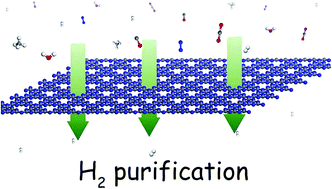Heptazine-based graphitic carbon nitride as an effective hydrogen purification membrane†
Abstract
The purification of H2 from other gases (CH4, CO, CO2, N2, and H2O) is a vital step for its safe usage. By using first-principles calculations and molecular dynamics simulations, we find that the porous graphitic carbon nitride (g-C3N4) monolayer works as an efficient and highly selective hydrogen purification membrane. In the DFT calculations, the transition state theory is used to search the lowest diffusion barrier (0.55 eV) for H2 to go through the well-ordered intrinsic holes. Meanwhile, the excellent selectivity between H2 and other gases shows that the g-C3N4 nanosheet is specific for diffusion of H2. The MD simulations exhibit the whole dynamic purification process and confirm our previous DFT results. Our results indicate that the g-C3N4 nanosheet has great potential in separating H2 from undesirable gases.

- This article is part of the themed collection: 2D Materials: Explorations Beyond Graphene

 Please wait while we load your content...
Please wait while we load your content...